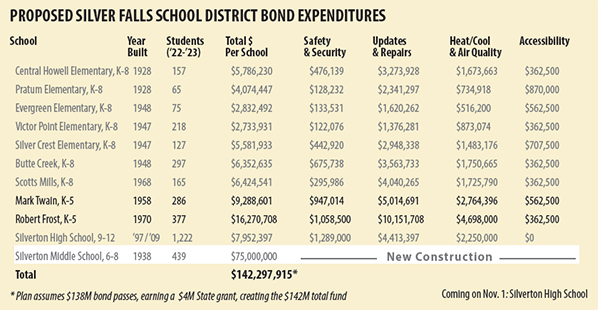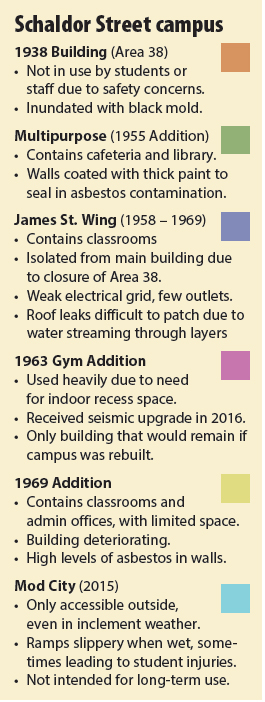By Stephen Floyd
There aren’t a lot of mild opinions about plans to rebuild Silverton Middle School through a proposed facilities bond for the Silver Falls School District.
Supporters of the $138 million bond describe the 1938 wing of the middle school as beyond saving and say it could have collapsed in on itself years ago.
Opponents argue the $75 million plan for a new building is a clear example of government overspending and accuse the district of failing to care for what it already has.
Our Town spoke to those in charge of maintaining the middle school, as well as past and present staff members. They described a campus that is already difficult and expensive to maintain, and said caring for the facility long-term would be more costly than a new building.
Over the last several months the SFSD Bond Advisory Committee and district officials – following a series of school-by-school community listening sessions – constructed a plan to address critical facility challenges to student safety and well-being.
After reviewing the proposal, the SFSD board decided to put the $138 million bond measure necessary to carry out those plans before the voters on the Nov. 7 ballot. If passed, a state grant of $4 million would also be awarded.
The bond addresses repairs and renovations at ten district-owned schools, and replaces Silverton Middle School.
For property owners within the district, the estimated cost per thousand tax increase over the current rate is $1.60 per $1,000 in assessed value.
 Not meant to be SMS
Not meant to be SMS
The former Silverton High School became Silverton Middle School in 2016 after the district had to close Eugene Field Elementary School.
A bond to save Eugene Field failed in 2014 and grade schoolers were moved into what had been Mark Twain Middle School. Students in 6th-8th grades then moved into parts of what used to be Silverton High School on Schlador Street, not the 1938 original building but the additional wings built in the ’50s and ’60s.
Derek McElfresh, the district’s director of communications, got his start full-time with SFSD at the high school in 2006 as coordinator for the Talented and Gifted Education program. His office was in the 1938 wing, and he recalled how on his first day he received confusing instructions on what to do during an emergency.
McElfresh said his supervisor told him, if an earthquake hits, don’t duck and cover, just run. He said he thought they might be hazing the new guy, but then his supervisor insisted an earthquake would bring down the masonary wall behind his desk and probably the second-story hallway.
“This is taking time off my life,” McElfresh said of working in the old building. “… In 2006, you could tell you shouldn’t be in that room.”
The Schlador Street campus remained occupied until the current Silverton High School was completed in 2009 on nearby Pine Street. At that time the school board floated multiple ideas including selling the property or demolishing the building, but according to McElfresh never intended to keep it as a school.
Roof like a waterbed
During the years that followed, minimal maintenance was performed on the campus. In the 1938 building, sections of the roof have collapsed, black mold grows throughout the interior, and a crack large enough to let in daylight has developed in a wall in the former theater.
Assistant Director of Facilities Dustin Hoehne said the 1938 roof also suffers from water inundation due to aging layers and unpatched leaks. He said, last year during the rainy season, there was so much water trapped in the roof it felt like walking on a waterbed.
Hoehne said the roofs on the newer parts of the campus are also problematic. Layer upon layer of patches and short-term fixes have created paths water can weave through, resulting in leaks that are sometimes far from the water’s point of origin.
And if water damages one of the many sections of the building contaminated with asbestos, facilities staff have to wait for contractors to abate the problem before their work can begin. Hoehne added this process is not cheap.

Locking down ‘Area 38’
When the middle school students moved to the Schlador Street campus, the district spent around $5.5 million on repairs and upgrades to prepare for incoming students. This included a $1.5 million state seismic grant and a $2.55 million loan SFSD will be paying off until 2028.
The 1938 wing could not be brought up to code. It was closed off to all students and staff and dubbed “Area 38”. Now the only people with access are Principal Brett Davisson, a security staffer and facilities employees.
Davisson said he and the security staffer may need to use Area 38 if there is an emergency in the James Street wing, as walking around Area 38 takes much longer than going through.
He pointed out this is an issue every day at the school, because students passing from one end of campus to the other must walk around Area 38, rain or shine.
Maintenance staff have access to Area 38 because the main utility systems, including electricity, plumbing, the boilers and the internet, run through the building.
The cafeteria, located in a newer wing of the school, had to be split in two to make room for a library, which was previously housed in Area 38. Dense paint was added to the walls to seal in high levels of asbestos. Davisson said this has created an echo-chamber effect, making the two rooms impractical for events like dances, concerts or even staff meetings.
Because the 17 classrooms in Area 38 are off-limits, the district brought in four double-wides and a single-wide in an array it calls “Mod City.” McElfresh noted many of these modulars were past their expected lifetimes when the district acquired them and they have continued to age.

The mods are accessible by a series of metal ramps and platforms known at the school as “cheese graters.” This is because they are full of metal holes meant to provide traction during foul weather, but officials say they are actually quite slick when wet.
The list of issues goes on and includes crumbling concrete stairs, water leaking into light fixtures and an electrical grid that can’t handle a microwave and projector running on the same breaker.
Facilities Director Jeff Alderman said, with so much deferred maintenance, it makes sense to start over, kind of like how a tooth can receive only so many fillings before it needs to be pulled out.
The district did look at the potential cost of renovating the current campus, which came to an estimated $68 million. While this was cheaper than a new building, McElfresh said this was the “what-we-know-about price” and Alderman agreed hidden problems would likely drive up costs.
Davisson added renovations would not necessarily prolong the life of an 85-year-old section and in the long run a new building would be cheaper.
“Pouring money into something that is not going to last is a concern,” he said. “I believe in shooting for a high goal, and ‘good enough’ is not a high goal.”